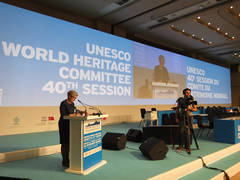World Heritage Committee opens in Istanbul
The 40th session of the World Heritage Committee on 8 July opened in Istanbul (Turkey) under the chairmanship of Lale Ülker, Ambassador, Director General of Cultural Affairs and Promotion Abroad of the Turkish Ministry of Foreign Affairs. The opening ceremony was an opportunity to stress that World Heritage, which is now, more than ever, the subject of numerous threats, must remain a vector of cohesion and dialogue at the international level.

The Deputy Prime Minister Numan Kurtulmuş of Turkey, in his introductory remarks, said there is a fundamental role to be played by culture and heritage, a role made even more crucial in a period marked by wars and terrorist attacks. "UNESCO's mission is to protect our shared values [...] and this role is even more crucial today as we live in difficult times," he said. "The best response to these attacks is not only political, but also artistic and cultural. We need to stand together."
UNESCO Director-General Irina Bokova said World Heritage embodies a revolutionary idea, “the idea that people of all cultures and faith can unite around outstanding universal value. When a World Heritage site is destroyed anywhere in the world, we all suffer, we are all diminished, even if it is from another region, another period, another culture,” she said. “What is at stake here is more than adding new sites on a list. It is about reaffirming human values and human rights. It is about healing wounded memories, harnessing heritage to regain confidence, to recover and look into the future,” the Director-General added.
Turkish Culture Minister Nabi Avcı meanwhile insisted on the fact that UNESCO is best placed to promote cooperation. “UNESCO is the banner-holder of soft power, a fundamental principle upon which peace can be built,” he said.
“Nowadays, we all witness threats to World Heritage. To attack heritage is to attack history, identity and values of people,” said Committee Chairwoman, Ambassador Ülker. “In front of such threat, we have to stand united. During our session, on the basis of actions already undertaken, we will discuss further measures to face these threats.”
President of the General Conference Stanley Mutumba Simataa spoke to the relevance of the World Heritage Convention. “At a time of ever increasing threats to natural and cultural sites, the Convention is a key tool to empower the international community to safeguard, protect, promote and transmit our heritage to future generations.”
“In this regard, I strongly believe it is our duty to strengthen the role of UNESCO in the protection of heritage in conflict areas and to ensure the protection and preservation of sites in areas affected by natural disaster,” said Ambassador Michael Worbs, Chairperson of the Executive Board of UNESCO.
Many celebrities, including Kadir Topbaş, Mayor of Istanbul or Öcal Oğuz, President of the Turkish National Commission for UNESCO, took part in this ceremony attended by some 800 participants.
During this session, the World Heritage Committee will consider the nominations of 27 sites on the List of UNESCO World Heritage. These include nine new natural sites, 14 cultural sites and four mixed sites (i.e. both natural and cultural).
The 27 nominations that will be examined are:
Natural sites:
◆ Mistaken Point (Canada)
◆ Hubei Shennongjia (China)
◆ Techno-volcanic Ensemble of the Chaîne des Puys and Limagne Fault (France)
◆ Lut Desert (Islamic Republic of Iran)
◆ Western Tien Shan (Kazakhstan, Kyrgyzstan, Uzbekistan)
◆ Archipiélago de Revillagigedo (Mexico)
◆ Sanganeb Marine National Park and Dungonab Bay—Mukkawar Island National Park (Sudan)
◆ Kaeng Krachan Forest Complex (Thailand)
◆ Mountain Ecosystems of Koytendag (Turkmenistan)
Mixed natural and cultural sites:
◆ Pimachiowin Aki (Canada)
◆ Ennedi Massif: Natural and Cultural Landscape (Chad)
◆ Khangchendzonga National Park (India)
◆ The Ahwar of Southern Iraq: Refuge of Biodiversity and the Relict Landscape of the Mesopotamian Cities (Iraq)
Cultural sites:
◆ Antigua Naval Dockyard and Related Archaeological Sites (Antigua and Barbuda)
◆ The Architectural Work of Le Corbusier, an Outstanding Contribution to the Modern Movement (Argentina, Belgium, France, Germany, India, Japan, Switzerland)
◆ Stećci—Medieval Tombstones (Bosnia and Herzegovina, Croatia, Montenegro, Serbia)
◆ Pampulha Modern Ensemble (Brazil)
◆ Zuojiang Huashan Rock Art Cultural Landscape (China)
◆ Archaeological Site of Philippi (Greece)
◆ Excavated Remains of Nalanda Mahavihara (India)
◆ Persian Qanat (Islamic Republic of Iran)
◆ Nan Madol: Ceremonial Centre of Eastern Micronesia (Federated States of Micronesia) [Proposed for simultaneous inscription on the List of World Heritage in Danger]
◆ Archaeological Site and Historic Centre of Panamá City [Significant boundary modification of the Archaeological Site of Panamá Viejo and Historic District of Panamá] (Panama)
◆ Antequera Dolmens Site (Spain)
◆ Archaeological site of Ani (Turkey)
◆ Gibraltar Neanderthal Caves and Environments (United Kingdom)
◆ Key Works of Modern Architecture by Frank Lloyd Wright (United States of America)
Source: United Nations Educational Scientific and Cultural Organization
- 301 reads
Human Rights
Ringing FOWPAL’s Peace Bell for the World:Nobel Peace Prize Laureates’ Visions and Actions

Protecting the World’s Cultural Diversity for a Sustainable Future

The Peace Bell Resonates at the 27th Eurasian Economic Summit

Declaration of World Day of the Power of Hope Endorsed by People in 158 Nations

Puppet Show I International Friendship Day 2020

